Abstract
The mosquito-active protein crystals produced by Bacillus thuringiensis subsp. israelensis contain covalently attached aminosugars which are critical for their larvicidal activity. The 50% lethal concentrations toward Aedes aegypti larvae were increased up to 10-fold by mild periodate treatment, up to 40-fold by forming the protein crystals in the presence of tunicamycin, and up to 7-fold by the presence during the mosquito bioassays of N-acetylglucosamine or its trimer, triacetylchitotriose. Periodate-treated crystals and crystals formed in the presence of tunicamycin had greatly reduced binding capacities for wheat germ agglutinin, an N-acetylglucosamine-specific lectin. These results suggest that the B. thuringiensis subsp. israelensis glycoprotein toxin binds to a lectinlike receptor in the larval mosquito gut. Furthermore, the distinct lectin-binding patterns exhibited by diptera-active versus lepidoptera-active B. thuringiensis crystals suggest that host specificity for the microbial insecticides is determined, in part, by the carbohydrate portion of their glycoprotein crystals.
Full text
PDF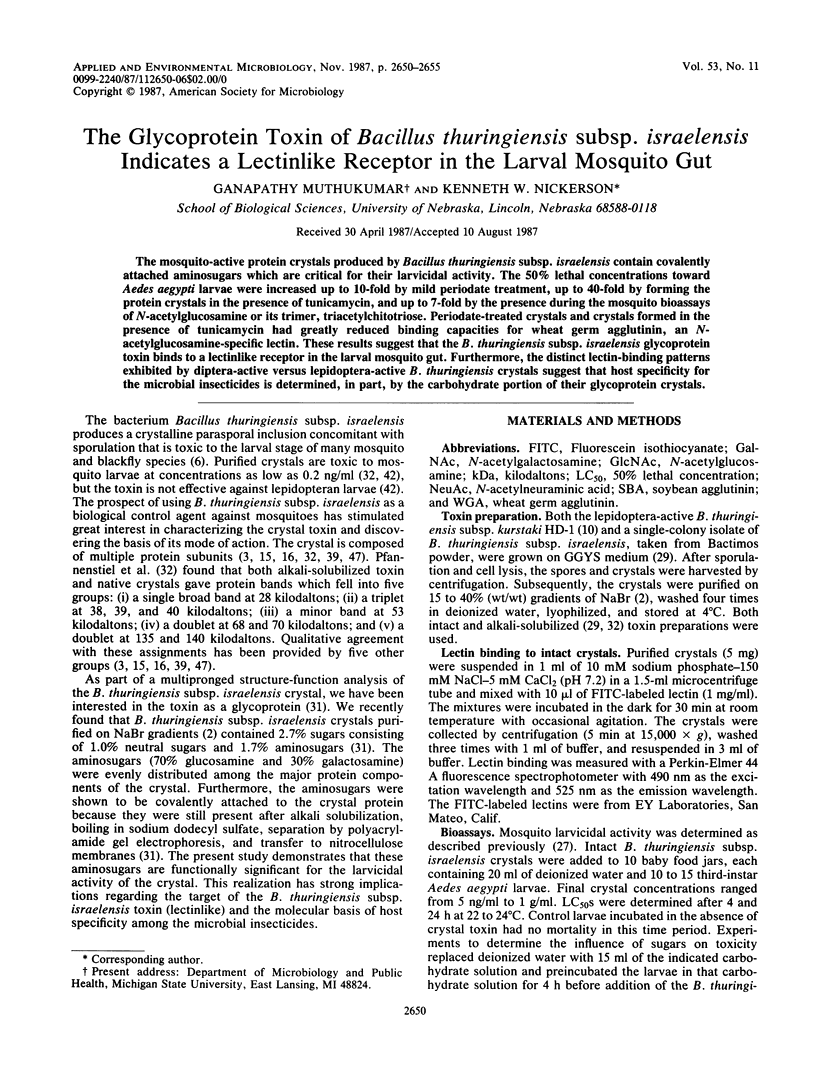
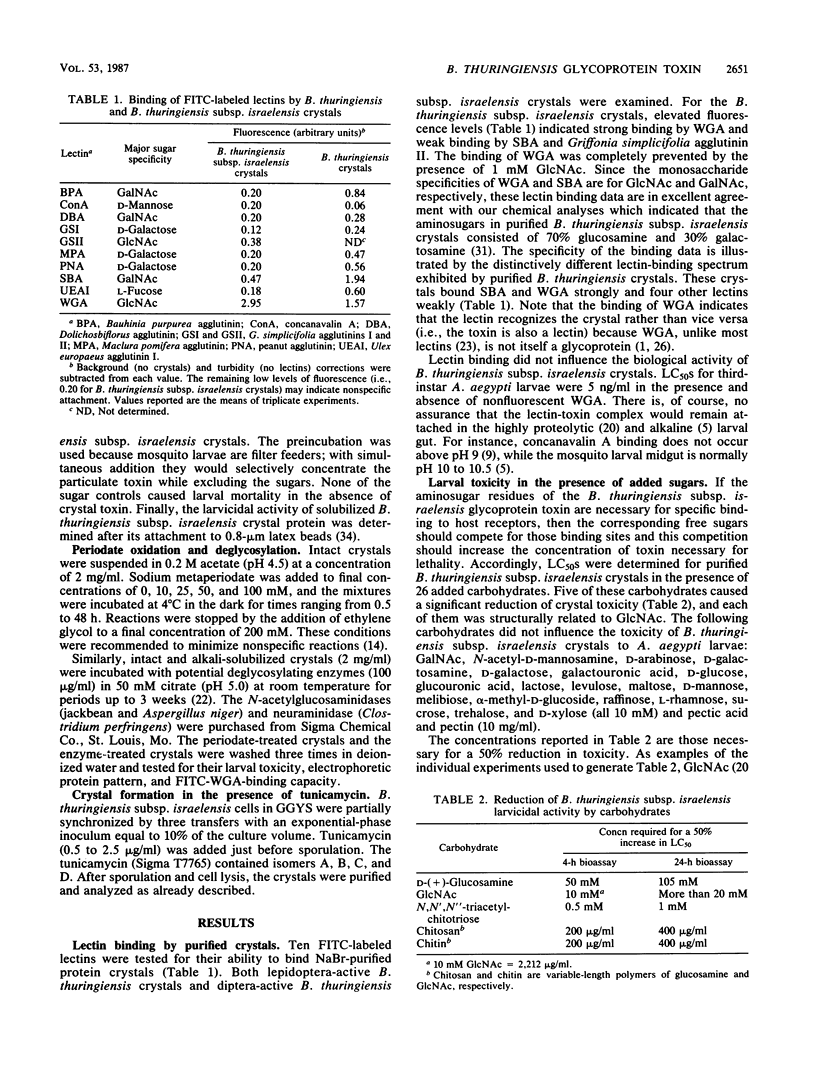
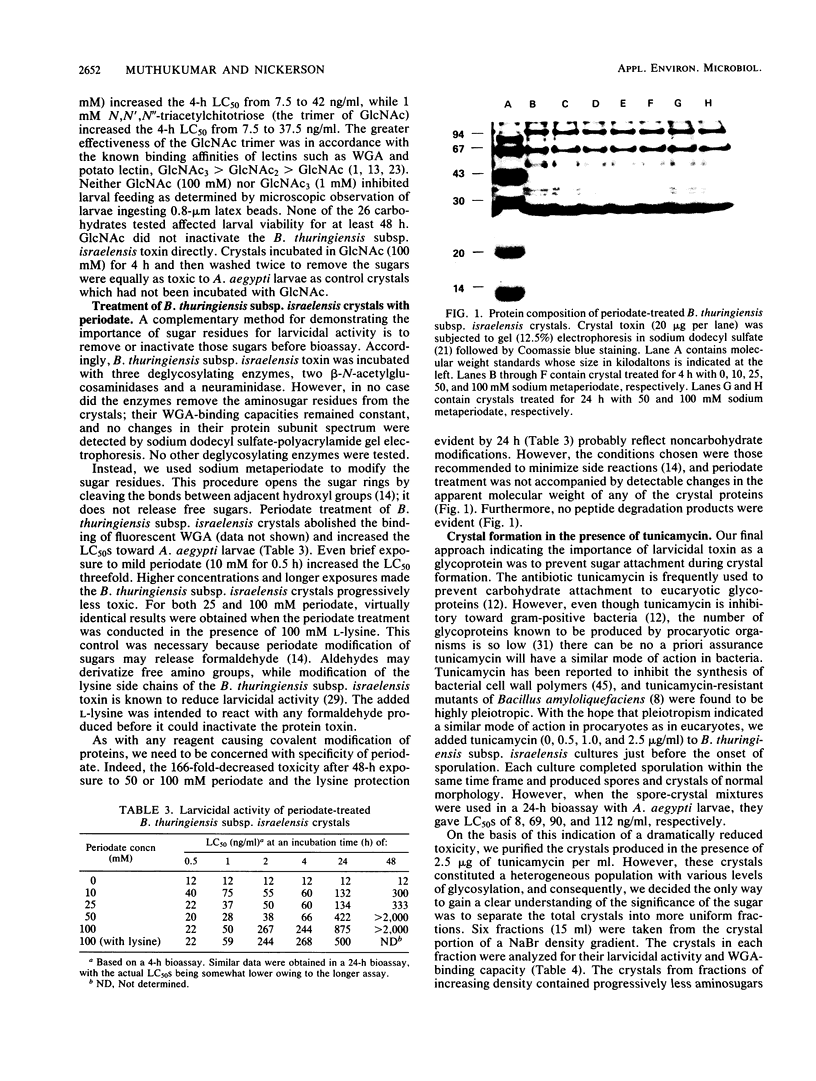
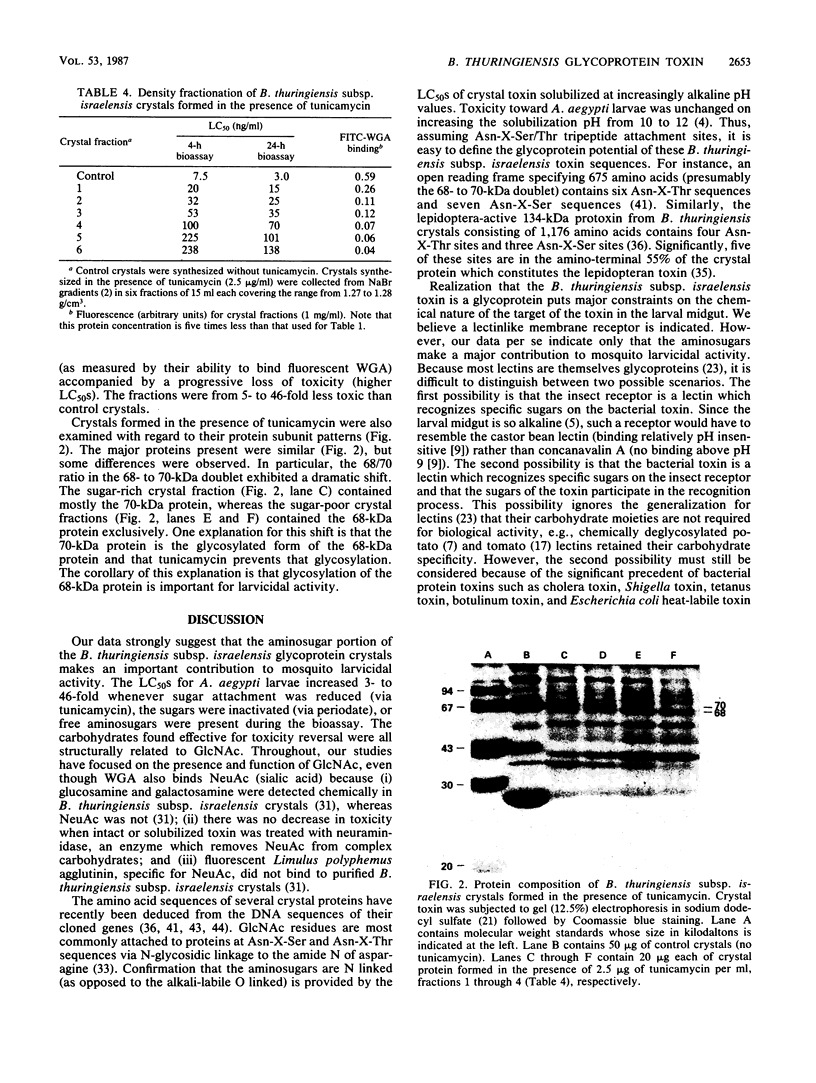
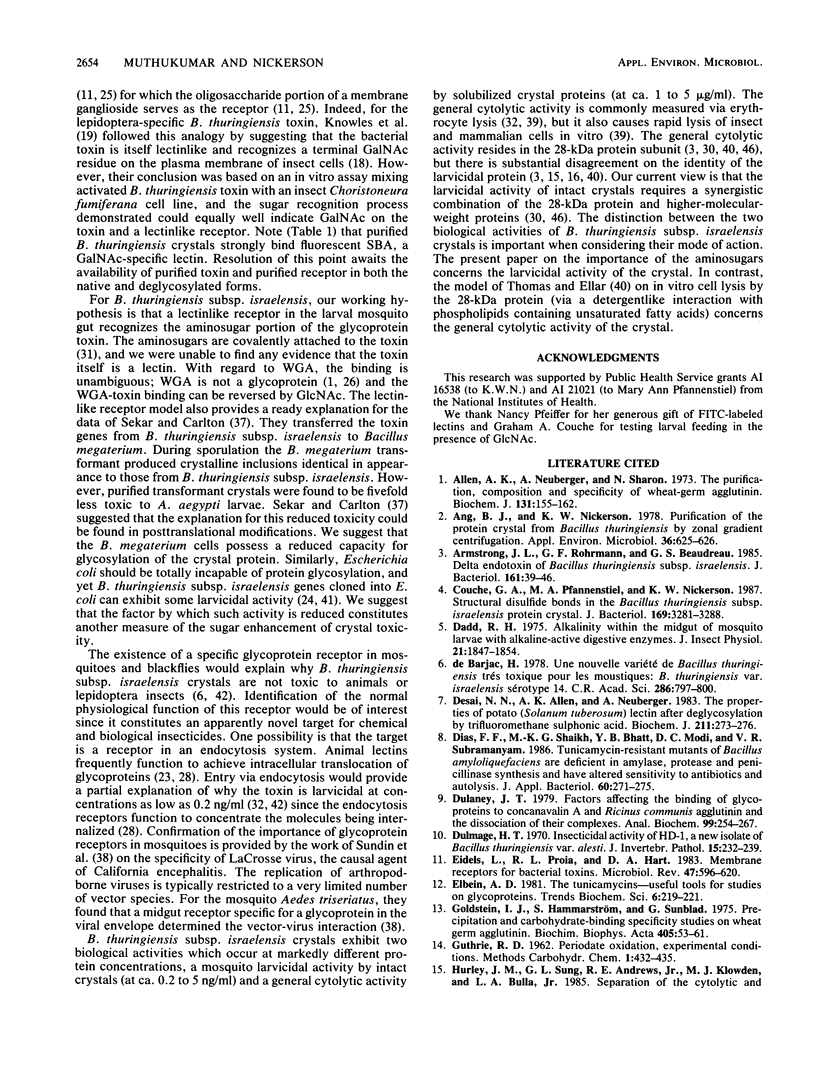
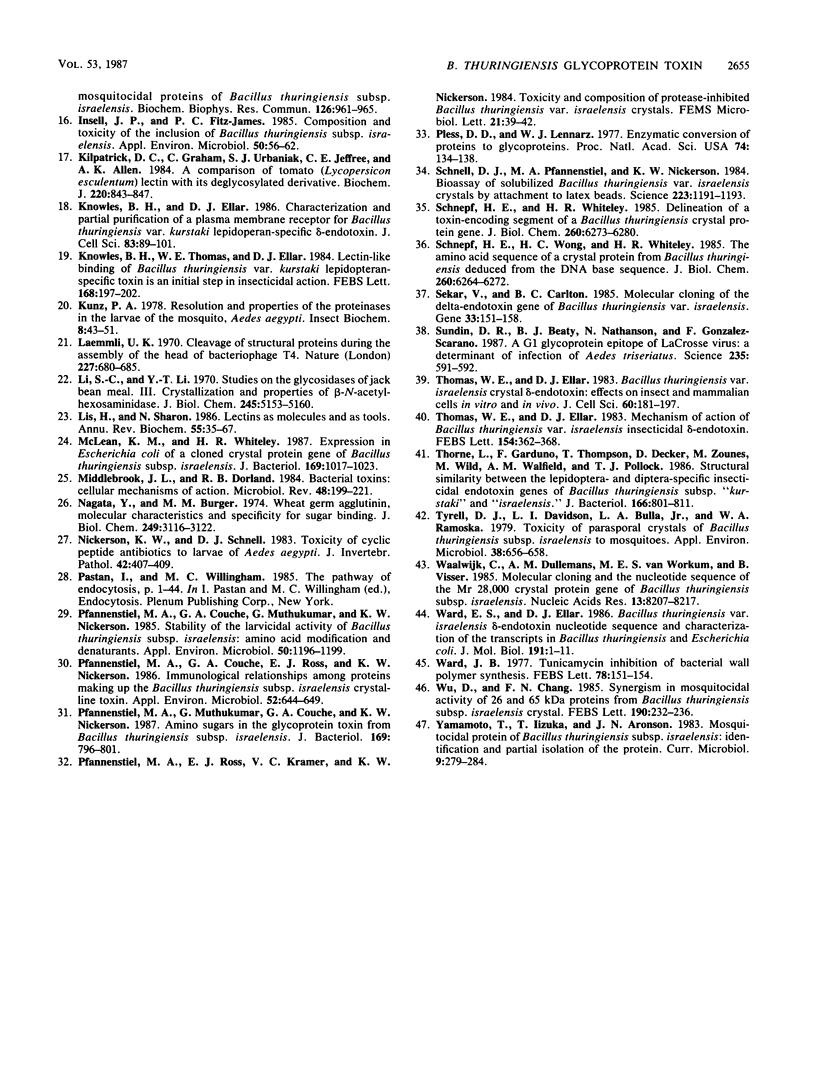
Images in this article
Selected References
These references are in PubMed. This may not be the complete list of references from this article.
- Allen A. K., Neuberger A., Sharon N. The purification, composition and specificity of wheat-germ agglutinin. Biochem J. 1973 Jan;131(1):155–162. doi: 10.1042/bj1310155. [DOI] [PMC free article] [PubMed] [Google Scholar]
- Ang B. J., Nickerson K. W. Purification of the protein crystal from Bacillus thuringiensis by zonal gradient centrifugation. Appl Environ Microbiol. 1978 Oct;36(4):625–626. doi: 10.1128/aem.36.4.625-626.1978. [DOI] [PMC free article] [PubMed] [Google Scholar]
- Armstrong J. L., Rohrmann G. F., Beaudreau G. S. Delta endotoxin of Bacillus thuringiensis subsp. israelensis. J Bacteriol. 1985 Jan;161(1):39–46. doi: 10.1128/jb.161.1.39-46.1985. [DOI] [PMC free article] [PubMed] [Google Scholar]
- Couche G. A., Pfannenstiel M. A., Nickerson K. W. Structural disulfide bonds in the Bacillus thuringiensis subsp. israelensis protein crystal. J Bacteriol. 1987 Jul;169(7):3281–3288. doi: 10.1128/jb.169.7.3281-3288.1987. [DOI] [PMC free article] [PubMed] [Google Scholar]
- Dadd R. H. Alkalinity within the midgut of mosquito larvae with alkaline-active digestive enzymes. J Insect Physiol. 1975 Nov;21(11):1847–1853. doi: 10.1016/0022-1910(75)90252-8. [DOI] [PubMed] [Google Scholar]
- Desai N. N., Allen A. K., Neuberger A. The properties of potato (Solanum tuberosum) lectin after deglycosylation by trifluoromethanesulphonic acid. Biochem J. 1983 Apr 1;211(1):273–276. doi: 10.1042/bj2110273. [DOI] [PMC free article] [PubMed] [Google Scholar]
- Dias F. F., Shaikh M. K., Bhatt Y. B., Modi D. C., Subramanyam V. R. Tunicamycin-resistant mutants of Bacillus amyloliquefaciens are deficient in amylase, protease and penicillinase synthesis and have altered sensitivity to antibiotics and autolysis. J Appl Bacteriol. 1986 Apr;60(4):271–275. doi: 10.1111/j.1365-2672.1986.tb01733.x. [DOI] [PubMed] [Google Scholar]
- Dulaney J. T. Factors affecting the binding of glycoproteins to concanavalin A and Ricinus communis agglutinin and the dissociation of their complexes. Anal Biochem. 1979 Nov 1;99(2):254–267. doi: 10.1016/s0003-2697(79)80004-4. [DOI] [PubMed] [Google Scholar]
- Eidels L., Proia R. L., Hart D. A. Membrane receptors for bacterial toxins. Microbiol Rev. 1983 Dec;47(4):596–620. doi: 10.1128/mr.47.4.596-620.1983. [DOI] [PMC free article] [PubMed] [Google Scholar]
- Goldstein I. J., Hammarström S., Sundblad G. Precipitation and carbohydrate-binding specificity studies on wheat germ agglutinin. Biochim Biophys Acta. 1975 Sep 9;405(1):53–61. doi: 10.1016/0005-2795(75)90313-x. [DOI] [PubMed] [Google Scholar]
- Hurley J. M., Lee S. G., Andrews R. E., Jr, Klowden M. J., Bulla L. A., Jr Separation of the cytolytic and mosquitocidal proteins of Bacillus thuringiensis subsp. israelensis. Biochem Biophys Res Commun. 1985 Jan 31;126(2):961–965. doi: 10.1016/0006-291x(85)90279-7. [DOI] [PubMed] [Google Scholar]
- Insell J. P., Fitz-James P. C. Composition and Toxicity of the Inclusion of Bacillus thuringiensis subsp. israelensis. Appl Environ Microbiol. 1985 Jul;50(1):56–62. doi: 10.1128/aem.50.1.56-62.1985. [DOI] [PMC free article] [PubMed] [Google Scholar]
- Kilpatrick D. C., Graham C., Urbaniak S. J., Jeffree C. E., Allen A. K. A comparison of tomato (Lycopersicon esculentum) lectin with its deglycosylated derivative. Biochem J. 1984 Jun 15;220(3):843–847. doi: 10.1042/bj2200843. [DOI] [PMC free article] [PubMed] [Google Scholar]
- Knowles B. H., Ellar D. J. Characterization and partial purification of a plasma membrane receptor for Bacillus thuringiensis var. kurstaki lepidopteran-specific delta-endotoxin. J Cell Sci. 1986 Jul;83:89–101. doi: 10.1242/jcs.83.1.89. [DOI] [PubMed] [Google Scholar]
- Knowles B. H., Thomas W. E., Ellar D. J. Lectin-like binding of Bacillus thuringiensis var. kurstaki lepidopteran-specific toxin is an initial step in insecticidal action. FEBS Lett. 1984 Mar 26;168(2):197–202. doi: 10.1016/0014-5793(84)80245-8. [DOI] [PubMed] [Google Scholar]
- Laemmli U. K. Cleavage of structural proteins during the assembly of the head of bacteriophage T4. Nature. 1970 Aug 15;227(5259):680–685. doi: 10.1038/227680a0. [DOI] [PubMed] [Google Scholar]
- Li S. C., Li Y. T. Studies on the glycosidases of jack bean meal. 3. Crystallization and properties of beta-N-acetylhexosaminidase. J Biol Chem. 1970 Oct 10;245(19):5153–5160. [PubMed] [Google Scholar]
- Lis H., Sharon N. Lectins as molecules and as tools. Annu Rev Biochem. 1986;55:35–67. doi: 10.1146/annurev.bi.55.070186.000343. [DOI] [PubMed] [Google Scholar]
- McLean K. M., Whiteley H. R. Expression in Escherichia coli of a cloned crystal protein gene of Bacillus thuringiensis subsp. israelensis. J Bacteriol. 1987 Mar;169(3):1017–1023. doi: 10.1128/jb.169.3.1017-1023.1987. [DOI] [PMC free article] [PubMed] [Google Scholar]
- Middlebrook J. L., Dorland R. B. Bacterial toxins: cellular mechanisms of action. Microbiol Rev. 1984 Sep;48(3):199–221. doi: 10.1128/mr.48.3.199-221.1984. [DOI] [PMC free article] [PubMed] [Google Scholar]
- Nagata Y., Burger M. M. Wheat germ agglutinin. Molecular characteristics and specificity for sugar binding. J Biol Chem. 1974 May 25;249(10):3116–3122. [PubMed] [Google Scholar]
- Nickerson K. W., Schnell D. J. Toxicity of cyclic peptide antibiotics to larvae of Aedes aegypti. J Invertebr Pathol. 1983 Nov;42(3):407–409. doi: 10.1016/0022-2011(83)90185-4. [DOI] [PubMed] [Google Scholar]
- Pfannenstiel M. A., Couche G. A., Muthukumar G., Nickerson K. W. Stability of the larvicidal activity of Bacillus thuringiensis subsp. israelensis: amino acid modification and denaturants. Appl Environ Microbiol. 1985 Nov;50(5):1196–1199. doi: 10.1128/aem.50.5.1196-1199.1985. [DOI] [PMC free article] [PubMed] [Google Scholar]
- Pfannenstiel M. A., Couche G. A., Ross E. J., Nickerson K. W. Immunological relationships among proteins making up the Bacillus thuringiensis subsp. israelensis crystalline toxin. Appl Environ Microbiol. 1986 Oct;52(4):644–649. doi: 10.1128/aem.52.4.644-649.1986. [DOI] [PMC free article] [PubMed] [Google Scholar]
- Pfannenstiel M. A., Muthukumar G., Couche G. A., Nickerson K. W. Amino sugars in the glycoprotein toxin from Bacillus thuringiensis subsp. israelensis. J Bacteriol. 1987 Feb;169(2):796–801. doi: 10.1128/jb.169.2.796-801.1987. [DOI] [PMC free article] [PubMed] [Google Scholar]
- Pless D. D., Lennarz W. J. Enzymatic conversion of proteins to glycoproteins. Proc Natl Acad Sci U S A. 1977 Jan;74(1):134–138. doi: 10.1073/pnas.74.1.134. [DOI] [PMC free article] [PubMed] [Google Scholar]
- Schnell D. J., Pfannenstiel M. A., Nickerson K. W. Bioassay of solubilized Bacillus thuringiensis var. israelensis crystals by attachment to latex beads. Science. 1984 Mar 16;223(4641):1191–1193. doi: 10.1126/science.6701520. [DOI] [PubMed] [Google Scholar]
- Schnepf H. E., Whiteley H. R. Delineation of a toxin-encoding segment of a Bacillus thuringiensis crystal protein gene. J Biol Chem. 1985 May 25;260(10):6273–6280. [PubMed] [Google Scholar]
- Schnepf H. E., Wong H. C., Whiteley H. R. The amino acid sequence of a crystal protein from Bacillus thuringiensis deduced from the DNA base sequence. J Biol Chem. 1985 May 25;260(10):6264–6272. [PubMed] [Google Scholar]
- Sekar V., Carlton B. C. Molecular cloning of the delta-endotoxin gene of Bacillus thuringiensis var. israelensis. Gene. 1985;33(2):151–158. doi: 10.1016/0378-1119(85)90089-7. [DOI] [PubMed] [Google Scholar]
- Sundin D. R., Beaty B. J., Nathanson N., Gonzalez-Scarano F. A G1 glycoprotein epitope of La Crosse virus: a determinant of infection of Aedes triseriatus. Science. 1987 Jan 30;235(4788):591–593. doi: 10.1126/science.3810159. [DOI] [PubMed] [Google Scholar]
- Thomas W. E., Ellar D. J. Bacillus thuringiensis var israelensis crystal delta-endotoxin: effects on insect and mammalian cells in vitro and in vivo. J Cell Sci. 1983 Mar;60:181–197. doi: 10.1242/jcs.60.1.181. [DOI] [PubMed] [Google Scholar]
- Thomas W. E., Ellar D. J. Mechanism of action of Bacillus thuringiensis var israelensis insecticidal delta-endotoxin. FEBS Lett. 1983 Apr 18;154(2):362–368. doi: 10.1016/0014-5793(83)80183-5. [DOI] [PubMed] [Google Scholar]
- Thorne L., Garduno F., Thompson T., Decker D., Zounes M., Wild M., Walfield A. M., Pollock T. J. Structural similarity between the lepidoptera- and diptera-specific insecticidal endotoxin genes of Bacillus thuringiensis subsp. "kurstaki" and "israelensis". J Bacteriol. 1986 Jun;166(3):801–811. doi: 10.1128/jb.166.3.801-811.1986. [DOI] [PMC free article] [PubMed] [Google Scholar]
- Tyrell D. J., Davidson L. I., Bulla L. A., Jr, Ramoska W. A. Toxicity of parasporal crystals of Bacillus thuringiensis subsp. israelensis to mosquitoes. Appl Environ Microbiol. 1979 Oct;38(4):656–658. doi: 10.1128/aem.38.4.656-658.1979. [DOI] [PMC free article] [PubMed] [Google Scholar]
- Waalwijk C., Dullemans A. M., van Workum M. E., Visser B. Molecular cloning and the nucleotide sequence of the Mr 28 000 crystal protein gene of Bacillus thuringiensis subsp. israelensis. Nucleic Acids Res. 1985 Nov 25;13(22):8207–8217. doi: 10.1093/nar/13.22.8207. [DOI] [PMC free article] [PubMed] [Google Scholar]
- Ward E. S., Ellar D. J. Bacillus thuringiensis var. israelensis delta-endotoxin. Nucleotide sequence and characterization of the transcripts in Bacillus thuringiensis and Escherichia coli. J Mol Biol. 1986 Sep 5;191(1):1–11. doi: 10.1016/0022-2836(86)90417-1. [DOI] [PubMed] [Google Scholar]
- Ward J. B. Tunicamycin inhibition of bacterial wall polymer synthesis. FEBS Lett. 1977;78(1):151–154. doi: 10.1016/0014-5793(77)80294-9. [DOI] [PubMed] [Google Scholar]
- de Barjac H. Une nouvelle variété de Bacillus thuringiensis très toxique pour les moustiques: B. thuringiensis var. israelensis sérotype 14. C R Acad Sci Hebd Seances Acad Sci D. 1978 Mar 13;286(10):797–800. [PubMed] [Google Scholar]




